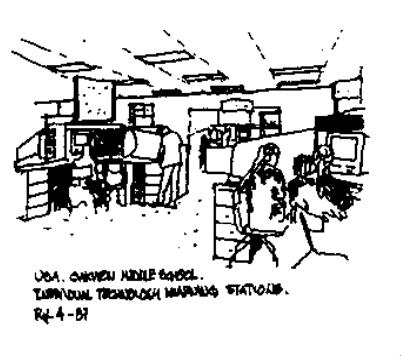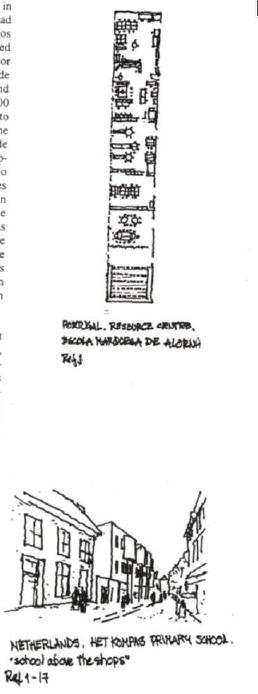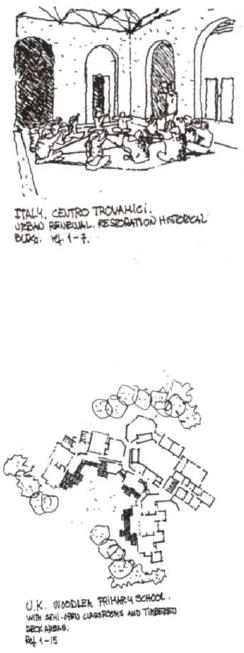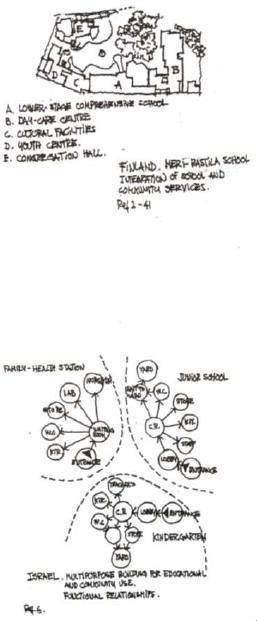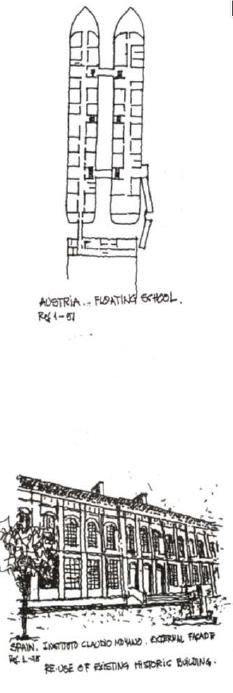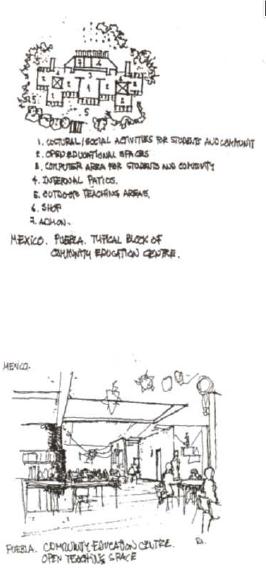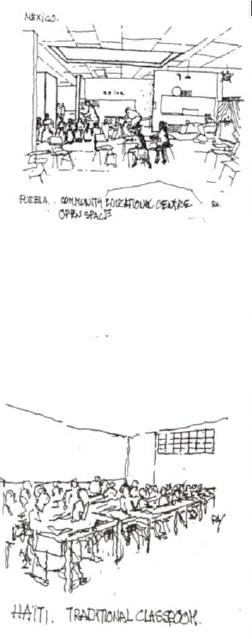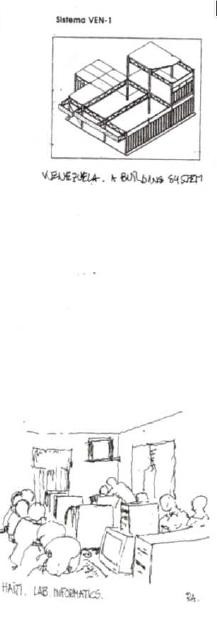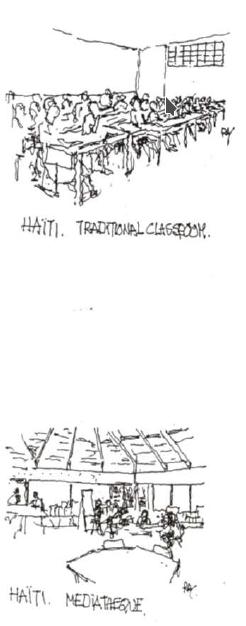|
|
|
|
The term `more developed regions' is taken from UNESCO's World Education Report 2000, and includes Northern America, Asia and Oceania (Australia, Japan and New Zealand) and Europe. |
|
Trends and patterns in educational buildings design in the more developed regions* and the situation in Latin America and the CaribbeanRodolfo Almeida, architectRegional Consultant on Educational Spaces for UNESCO Regional Office for Education for Latin America and the CaribbeanIntroduction1. This paper attempts to highlight the present trends in design of educational buildings in the more developed regions and the importance of architecture to improve the quality of education_ It will try to show how this is reflected in the Latin American and the Caribbean Region, and suggest activities (research, design, training and information) which still need to be further developed in the Region. The paper focuses mainly on quality aspects of design. without going into construction and cost issues.
2 It is the credo of our Working Group that good architectural design of an educational building improves the quality of education. Architecture has to be well adapted to the existing pedagogical content and teaching methods, and particularly to the rapidly evolving information technology. A good architectural building is also well adapted to local conditions and regional cultures within reasonable construction. operational and maintenance costs, and related to the community.
3. Architecture is also a tool for education in itself through its shapes, spaces. Volumes, colours, building materials, textures. relations to the outdoor learning spaces and to the environment, by using other sources of renewable energy and above all by inspiring the user with enthusiasm to learn in agreeable and beautiful physical environment and to feel part as an active member of his/her community. |
|
General background:quantity and quality
|
|
|
in Mexico, the Comite Adnunistrador del Programa Federal de Construccion de Escuelas (CAPFCE), created in 1944 and presently is decentralized (from 22.000 schools in 1944 the number increased to 170,000 schools in 1994); in Colombia the Instituto Colombiano de Construccian de Escuelas (ICCE), created in 3969 and suppressed in 1987; in Bolivia. the Consejo Nacional tie Construcciones Escolares (CONES), created in 1971 and suppressed in 1991; in Venezuela the Fundacion de Edificaciones y Dotaciones Educativas (FEDE) created in 1976 and presently in the process of decentralization. In Europe. France could be mentioned with the Direction des Batiments within the Ministry of Education which existed up to 1970. Many Eastern European countries also had central-units. 7. These central units were, in general, well set up with numerous professionals, architects, educators, engineers, and endowed with adequate financial resources. The central units developed their own national norms and typical schedules of accommodation and typical designs which were applied generally the same throughout the country. with more or less consideration to climatic and geographical aspects and generally without consultation and dialogue with the communities. But the important task was to respond to the increasing demand for education, and to enrol as many students as possible up to the more remotes areas of a country. Thousands of very similar schools were thus built in those and the majority are still in use. When the central units were suppressed, much of the trained staff disappeared, memory of experiences (good and bad) was forgotten, and maybe the most important was the loss of the valuable technical documentation accumulated throughout the years. 8. Presently the focus has shifted to quality. The ongoing decentralization process which started as from the late 1970s and which many countries are just now engaging in, has radically changed the above situation. |
|
Responsibilities for the financing. design, construction and maintenance of educational buildings are now in the hands of local authorities. Usually this refers to pre-school to upper secondary level. tertiary education being in the hands of the central level. This has as an objective, inter alia, to provide more adequate schools better adapted to the community they serve and to its cultural values, to the climatic and geographical situation, and more energy consumption saving onented. Local communities tend to participate more in the planning. design and maintenance of their schools. There is also a certain flexibility in some countries of local adjustments to the national timetables and curricula, as well as the introduction of additional courses by the local authorities. It must be stressed that educational buildings tend to be no longer confined to schooling but to provide services to the community! use of sport facilities, library. day-care centres. technical workshops. etc. also education goes out of the school. by using public libraries. theatres, museums, public markets, and the increasing use and development of information technology is having and will have an impact on the design of the buildings. There is an increasing interaction between the community and the school and vice versa. 9. Problems still exist, inter alia. depending on the capacity of each local authority. whether in human or financial resources. to define a sound educational and scam] project as well as its translation into architecture with their own means or appealing for assistance to at regional or central level; are local authorities capable of developing local inputs to curricula or do they need to resort to the compulsory national curricula; the lack of flexible norms that can be applied at local level. etc. In some countries. the "old" national norms have not yet been updated or new norms are not necessarily formulated with a new perspective in the light of educational. social and technological changes. All of these aspects will have an impact on the design of new premises and for the remodelling or reconversion of existing ones. |
|
10. Designs arc often subjected to approval. either by local authorities or by the central level. based on such norms to obtain financing or green light for construction. Often. it is because of the impulse of highly motivated architect and educator that good designs of excellent architectural/educational quality can come into existence. 11 This is leading, mainly in the more developed regions, to the production of a variety of designs of different types of new school buildings to satisfy the needs of each community and its context. almost case by case making the evaluation of designs more complex. Present trends affecting design in the more developed regions
14 The replies show a wide variation in the definition. understanding and application of space norms or guidelines. In fact. it goes from rigid situations. particularly in former Eastern European countries, where space norms (including definition of schedules of accommodation and room sizes and space per student are issued by the central government and are compulsory throughout the country with no adaptation to the local context: this situation is changing due to their on-going decentralization process. |
|
15 In Europe, the information obtained is that though they have central space norms, they do also have guidelines issued by the local goyernments. It seems that in one country there are many complicated catalogues of norms to comply with, making it difficult for architects and educators to put experimental ideas into practice. e.g. open learning workshop arid flexible zoning of spaces are hardly found, the standardisation of dimensions of each space makes an open and experimental approach to design difficult. However, in other European countries situation seems to be more flexible: local authorities in fact apply their guidelines case by case. schools having the freedom to emphasize certain factors corresponding to their needs, so that programmes are becoming more and more individually `tailored '. 16 In three countries, the conventional classroom is slowly disappearing in favour of smaller spaces for project-education. self-study space, multimedia centres; there is also a growing need for more appropriate facilities for science and technology. 17 One country adds family support and adult education facilities onto primary schools to counter social exclusion, creating for example, multi-agency centres and full service schools. 18 Israel has standard programmes for all types of educational spaces and schedules of accommodations. But for the 5 to 6 past years the trend is that the Ministry of Education allocates a budget based on the total area of the building, leaving the decision of the actual design to the municipalities. Many of them. however. still use the central programmes- 19. In addition to these detailed information received by country, the following relevant 'rends have been noted in the more developed regions, through publications, documentation and seminars. |
|
20 There is increased importance given to the involvement of local teams (architect/educator/community) in the whole design process: from the definition of educational specifications. schedules of accommodation to the actual architectural design. 21 Existing historical buildings are not only preserved. but are being restored and converted for educational use. 22 Imaginative solutions to solve the problem of scarcity of land are sometimes found, such as building schools on top of shops, or ships to accommodate influx of immigrants. 23 There is more respect and awareness for the environment and ecology; solutions which include energy conservation and use of renewable sources of energy arc being sought. 24 There is increased respect for local cultural values through the use of local architectural vocabulary and materials, in a contemporary spirit. 25 The school is opening up towards the community at large and is not only used as a school. 26 There is increased flexibility to adapt the design to changes in education structure and content, as well as to educational innovations such as individualised learning. 27 Information technology has entered strongly the learning process. This is changing the type of spaces, functional relationships within the building, producing innovative new ones, and takes education to people's homes. 28 Educational resource centres or multimedia centres take on increased importance and new ones are being designed and built. Conventional libraries are evolving towards multimedia centres. 29 Educational facilities art also being used as training centres for private companies. as was one school visited during the Cranbrook Seminar. |
|
|
30 Rural communities are obtaining educational buildings that provide them different public services such as health, libraries. museums. hostels, post offices 31 There is an increased multipurpose use of spaces. such as the use of circulation areas for recreation, gathering, cafeteria. community meetings. 32 To sum up. educational buildings have taken on more meaning for their communities. designed by them to meet their own aspirations, The Latin American and Caribbean Region33 In this Region many things are going on in education that are having an influence on the design of educational buildings: educational reforms, changes in structure of education. extension of the school day, raising of the compulsory school age. changes in content of education. etc 34 Other important factors to take into account are the still rapid demographic growth which puts more pressure on the educational system. the access to education for adults, etc. 35 Natural disasters have hit the Region more frequently and violently during the last decade, causing many deaths bus also tremendous damage to educational buildings: earthquakes in Mexico and Colombia, hurricanes in Central America and the Caribbean. and the hidrometeorological event that hit Venezuela in December 1999 taking between 25.000 to 50.000 human lives. 36 Below is some data taken from UNESCO's World Education Report 2000 for Latin America and the Caribbean in order to give an idea of the magnitude of the task countries have accomplished and are still facing; a) The estimated illiterate population aged 15 and over was 414 million in 1997. compared to 14.2 million in the more developed regions and countries in transition. |
|
b) The estimated numbers of out-of-school primary school age children for the Region are as follow: 1970: 10 million 2000: 5 million (c) Gross enrolment ratios for primary education (1970: 105 % and in 1997: 110 %); for secondary education (1970: 28 % and in 1997: 62 %) and for ternary education (1970: 6 % and in 1997: 20%) (d) Total enrolments for primary (1950: 15 million and in 1997: 85 million). secondary ( 1950: 2 million ana In 1997: 29 million), tertiary (1950: 0.3 million and in 1997: 9.4 million) 37 Below will be presented how the trends observed in the more developed regions are reflected in the Region. 38 Decentralization is taking 'place in the Region, in some countries rapidly as in the case of Chile. in others just barely starting. 39 Mexico and Venezuela are the only two countries in the Region with a specialized national institution for the planning, design and construction of educational buildings: the Coma Administrador del Programa Federal de Escuelas (CAPFCE) in Mexico. and the Fundacion de Edificaciones y Dotaciones Educativas (FEDE) in Venezuela 41 CAPFCE was created in Mexico in 1944. and presently has been decentralized to the individual States- Each State now has its own CAPFCE, yet norms and designs tend still to come from the central CAPFCE. It is expected that in future years a greater diversity of designs will be developed by each State according to its own needs and resources. |
|
41 In Venezuela. FEDE is being decentralized. but norms and designs are still developed at central level. FEDE, different than CAPFCE. is also responsible (or the maintenance of educational buildings. It has produced maintenance manuals and has developed over the years a unique experience in this field. FEDE also provides technical advice to other national institutions involved in school design and construction. 42 Though the trend is also changing towards giving more latitude to municipalities in their application of space norms and development of appropriate designs. there are still. though less than in previous years, typical designs being built in several countries of the Region. 43 More steps and actions are being taken to reduce the vulnerability of the educational systems to natural disasters, and to make safer buildings and safer locations in most of the countries. 44 Experiences of community participation in the design, use and maintenance of new types of educational buildings are also taking place in the Region. The Community Educational Centre in Puebla (Mexico) and the three Centres for Education for All in three rural communities in Venezuela can be mentioned. 45 The use of local materials and techniques is being revitalized not only for cost, but also for respect for local values and cultures. Raw earth has become a building material that is being used properly and safely. A UNESCO Chair has been created on Earth Architecture. coordinated by the CRATerre Group based in Grenoble. Several countries of the Region are part of this network: Brazil. Colombia. Peru. Mexico. 46 The changes of structure of the educational system poses problems to architects in the conversion and adaptation of existing buildings. |
|
In Argentina for instance primary education was extended. and thus some existing primary schools turn out too small whereas secondary schools are under-utilized. Some material was sent to me from Cordoba Province where architects are working on this complex aspect: remodelling and transformation of existing buildings and design of new ones for the new educational structure. 47 In the case of Brazil. as I have learned from our colleague Joao Mello Filho, there is a big deficit in secondary schools: more than 95% of the secondary schools are occupied by primary schools, and are not well adapted. He also signals that there are no more typical designs in Brazil done by the Ministry of Education. 48 Educational reforms are also posing challenges to architects in the Region. Like the case of Chile, where the educational reform not only includes changes of content, but the extension of the school day. this has created the need to remodel. reconvert or extend the existing educational buildings. The Ministry of Education has signed an agreement with the UNESCO Regional Office to implement jointly a project entitled: Optimization of the investment in educational buildings. The Ministry has a special Department for Infrastructure, headed by our colleague Jadille Baza. She and I co-ordinate the implementation of this project. 49 Information technology has entered the Region and is gradually changing the design of school buildings. Chile has a programme called "Enlace" which links by computer already many schools. Even in Haiti, which has the lowest GNP per capita in the Region, there are schools equipped with computers and adequate spaces are being created for this purpose. |
|
Conclusions50 The Region is making its own progress along the trends observed in Western and developed countries 51 There is still room for improvement. particularly in the preparation of an architect's brief more suited to the local educational and cultural aspirations and in the design of more flexible spaces, more related to and open to the community, and better adapted to the information technology. 52 In several countries, space norms need to be brought up to date to match educational. technological and sociological changes, particularly the new information technology, or to formulate new ones giving MOM flexibility at local level to adapt these norms. Safety standards-1's well as comfort norms need still to be improved. Already a number of countries are in the process of developing new design guidelines. 53 There is a need to develop and construct prototype buildings for new educational concepts. for information technology. for local and national materials, for providing a safe and optimal comfort environment, for reviving local culture and using renewable sources of energy. Lessons learned can be adapted and replicated to other parts of the country or to other countries. 54 Given the trends mentioned above, and in particular because of decentralization and educational reforms, the Region needs trained qualified architects. educators and community in the planning. design. construction and maintenance of educational facilities. 55 There is a vast need for collecting technical documentation and creating solid information centres at national and local levels. 56 The UNESCO Regional Office for Education for Latin America and the Caribbean is establishing a regional network of individuals. institutions, organizations involved in educational buildings planning. design, construction, maintenance and management. This network will facilitate the collection and exchange of national experience and the dissemination of technical handbooks, manuals, documents. |
|
References and BibliographyRef. 1 OECD/PEB. 1996. Schools for Today and Tomorrow. Paris. Ref. 2 OECD/TSB. 1998. Under One Roof The Integration of Schools and Community Services in OECD Countries, Paris. Ref. 3 Ministry of Education. Culture and Sciences. 1998, School Building Prize 1998. Amsterdam Ref. 4 American School & University. 1997. Architectural Portfolio 1997. Award-Winning and Other Outstanding School and University Buildings. Volume 70. Number 3. Overland Park. Ref. 5 Almeida, R. 1988. Handbook for Educational Buildings Planning. Educational Buildings and Equipment No. 9. Pans. UNESCO. Ref. 6 Institute for Development of Educational & Welfare Facilities. 1995. Multi-purpose Building for Educational and Community Services. Case Study in Israel. Educational Buildings and Equipment No. 20. Tel-Aviv: UNESCO. Ref. 7 Almeida. R. 1999. Patterns and strategies of designs for new school buildings. OECD. UNESCO/Santiago. Almeida. R. 1998. Centro Educativo Contunitario del Sur (CECSUR): mission report to Mexico. Unpublished. Puebla UNESCO. 2000. World Education Report 2000. The right to education: towards education for all throughout life. Ministry of Education Chile and UNESCO/Santiago. 1994. Seminario Espacios Educativos en Chile y Amirica Latina. Educational Buildings and Equipment No. 21. Santiago: UNESCO/Santiago Beynon, J. 1997. Physical Facilities for Education: What Planners need to know. Fundamentals of Educational Planning No. 57. Pans: UNESCO/IIEP El Jack. K; Almeida, R. 1980. Planning Educational Buildings: Basic Concepts. Reports and studies on educational policy planning: 580. Paris: UNESCO. OECD/PE.B 1992. New Technology and its Impact on Educational Buildings. Paris. UNESCO/IFEDE. 1997, Una Estrategia para la Eficiencia de la Planes Fisica Educativa. Esrudio de caso Venezuela. Educational Buildings and Equipment No. 23. Caracas. |
|
Drawings by Rodolfo Almeida based on photographs from the bibliography |
|
-23 24 25 26 27 28 29 30 31 32 33 34 35 36 37- |
|


